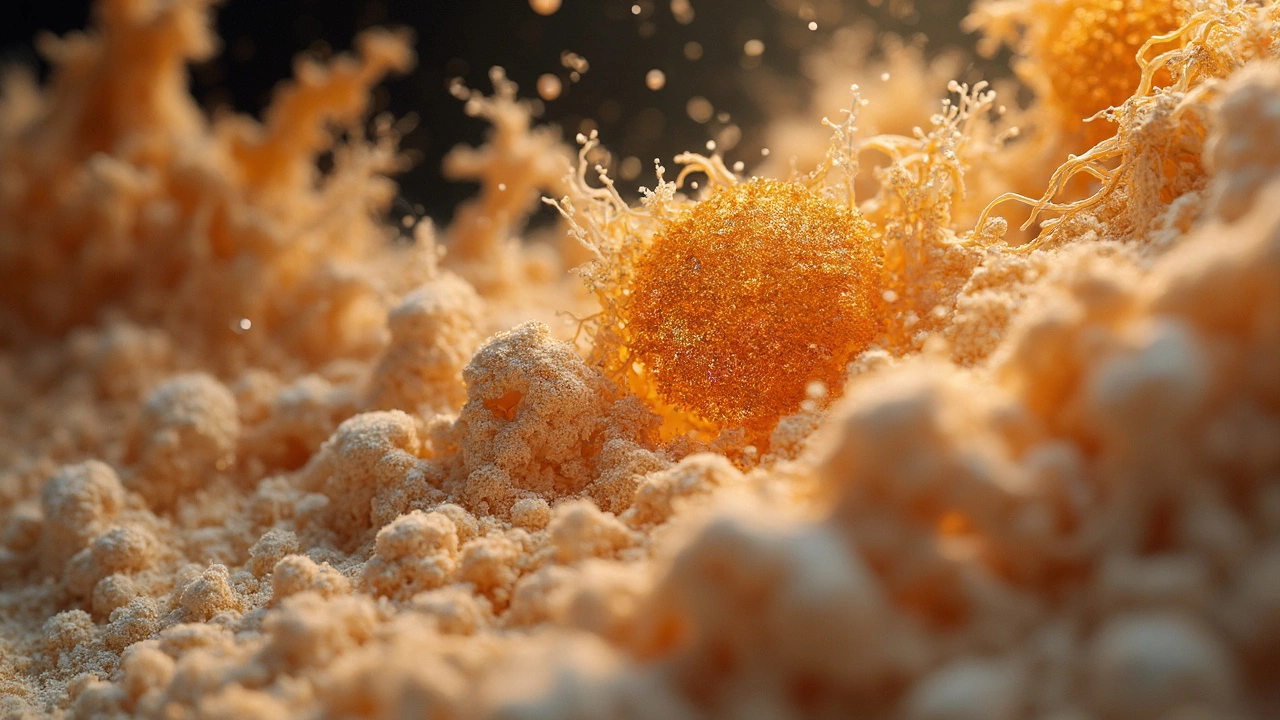Alright, let’s get right to it—μm stands for micrometer, and it's pretty darn important in food processing. It's a unit of length equal to one millionth of a meter. In the world of food, this tiny measurement helps define the texture, consistency, and even the taste of what we eat. Imagine grinding coffee beans. The size of the grind in μm affects the flavor. Same with flour for your bread or pasta; its fineness, measured in micrometers, gives you that dreamy texture.
Micrometers are like the unsung heroes in the kitchens of processing plants. Without them, you wouldn’t have the perfect blend of smooth peanut butter or the silky flow of your favorite chocolate. It's fascinating to think about how something so minute can have such a massive impact on what we eat, right? So next time you bite into a biscuit, think about the micrometers that helped make it just right.
- What is a μm and Why It Matters
- Applications of Microns in Food Processing
- Measuring Techniques and Equipment
- Ensuring Consistency in Food Quality
- Tips for Choosing the Right Equipment
What is a μm and Why It Matters
Let's unbox this—μm, also known as a micrometer, is the same as saying one-millionth of a meter. Imagine slicing a meter stick into a million equal bits, and yes, you get it, we're talking tiny! In food processing, these little guys help ensure that every spoonful or bite you take is consistent and just as expected.
Importance in Food Processing
Why does the food industry care so much about this? Accuracy. Think about uniformity in products like baby food or ensuring the perfect texture in sauces and spreads. The difference between a coarse and fine texture can often come down to the specifics of these minuscule measurement units.
Role of Micrometers in Everyday Products
Picture yourself enjoying that morning cup of joe. The coffee grind size, measured in microns, plays a crucial part in how your coffee will taste. Finer grinds can lead to more intense flavors. On the flip side, a coarser grind might leave you craving more. In the processing factories, keeping an eye on these measurements ensures that your food or drink item tastes just right, each time.
Moreover, if you've ever wondered why some foods have incredibly smooth textures, like your peanut butter or chocolate mousse, tip your hat to the correct use of micron sizes during processing. The grind size in the production line affects how finely it's milled.
Some Fun Insights Into Microns
Just for fun, did you know the average strand of human hair is about 70 microns in diameter? This shows just how tiny these measurements are and why they're pivotal in achieving that desired smooth, velvety finish in processed foods.
Average Micron Sizes in Various Foods
| Food Product | Average Micron Size |
|---|---|
| Flour | 200 μm |
| Chocolate | 20 μm |
| Grain for Bread | 500 μm |
So, the next time you savor your meal, remember that the subtle work of micrometers helped craft that deliciousness. Tiny but mighty, right?
Applications of Microns in Food Processing
When it comes to food processing, knowing the ins and outs of a micrometer can be a game-changer. It's not just about getting a recipe right; it's about achieving consistent quality on a large scale. Micrometers help in measuring particle size which is crucial across different food products.
The Role in Grinding and Crushing
Ever wondered how your favorite chocolate bar gets that velvety texture? It boils down to the grind size, often measured in microns. The smaller the particle, the smoother the texture. This is especially important in confections and coffee grinding. In fact, a good espresso requires coffee grounds around 300-500 μm for that perfect shot.
Emulsification and Homogenization
In emulsification, especially when creating sauces or even dairy products, consistent droplet size measured in microns is key. A research paper published by the Food Science and Technology journal highlights,
"Achieving the right micron size ensures a stable emulsion, which is essential for shelf life and taste."Homogenization, especially in milk, aims for fat globules around 1 μm, ensuring your milk is smooth without that annoying cream layer on top.
Spray Drying and Powder Creation
Spray drying is a nifty technique used for creating milk powder, instant coffee, and baby formula. The spray nozzles aim for tiny droplets, often less than 50 μm, maximizing surface area and creating a fine, dry powder. This process helps retain flavor and nutrients while providing a long shelf-life.
Understanding Particle Size Distribution
In many food products, consistency is vital—not just in taste, but in texture. Here's where particle size distribution (PSD) graphs come into play. These PSDs show how particles of various sizes are distributed in a food sample, right down to the micrometers. It's like the blueprint for the perfect bite.
| Product | Ideal Micron Size |
|---|---|
| Espresso Coffee | 300-500 μm |
| Smooth Peanut Butter | 20 μm |
| Milk Powder | <50 μm |
Knowing the ideal micron size for various products can ensure your process hits that sweet spot, figuratively and literally. In the end, the magic of microns in food processing is all about hitting that balance between science and taste.

Measuring Techniques and Equipment
When it comes to getting precise in food processing, measuring the size of ingredients can make or break the product's quality. So, how exactly do we measure those teeny tiny micrometers? Let's dive into the methods and the gear that get us there.
The Techniques
The most common technique for measuring particle size in food is laser diffraction. This method analyzes particles by measuring the angle and intensity of light scattered by a sample. It's fast, accurate, and works well for a wide range of particle sizes, making it a go-to choice in many food industries.
Another method you might hear about is the sieve analysis. It’s a tad more old-school but still handy. Here, you pour your material through a series of stacked sieves, each finer than the last. By weighing what’s left in each sieve, you can estimate the size distribution of the particles.
The Equipment
For laser diffraction, you'll need a laser particle size analyzer. These machines aren’t exactly kitchen appliances, but they’re vital in labs and large-scale processing units. They provide highly accurate results quickly, which is critical when you’re working with massive batches of food products.
If you're leaning towards the sieve side, a set of standard sieves will do, paired with a sieve shaker for efficiency. This setup is more budget-friendly and provides a good visual representation of particle size, which can be quite handy in some scenarios.
Picking the Right Gear
Choosing between these tools often boils down to your specific needs and budget. For precise, quick results, and if you’re dealing with a wide range of particle sizes, a laser particle analyzer is worth the investment. For smaller operations or where budget’s a bit tighter, sieve analysis provides enough insight without breaking the bank.
Here's a quick look at some considerations:
- Accuracy Needs: If you need precision within a micron, go for laser diffraction.
- Budget Constraints: Sieve analysis is more affordable.
- Sample Volume: Larger operations may benefit more from laser diffraction speed.
Remember, getting your micrometer measurements right isn’t just about having fancy gadgets—it's about ensuring every bite of your product is deliciously consistent!
Ensuring Consistency in Food Quality
Having a consistent quality in food products isn't just wishful thinking; it's actually a cornerstone in the food processing industry. When everything is measured in micrometers, maintaining uniformity is crucial. It's about guaranteeing every cookie in a bag tastes exactly as delightful as the last. Easier said than done, right?
The Role of Measurement
Using the micrometer measurement precisely impacts food texture and quality. For products like yogurt and cheese, the consistency of processed mixtures can make or break the end product. Imagine a lumpy yogurt or gritty cheese—not very appealing!
Consistency Techniques
Producers often use industrial sieves and laser diffraction tools to achieve the required particle sizes. Digital microscopes might also come into play. These tools ensure each ingredient is prepped to perfection, making every batch uniform.
“Consistency is what customers expect, and without precise measurement, you can't deliver it,” says Dr. Laura Campos, a food technology specialist.
With measurements down to the micron-level, precise techniques help avoid fluctuations in product quality, resulting in uniform texture and taste across all batches. It's the behind-the-scenes magic that food lovers appreciate but rarely notice.
Tying It All Together
But it’s not just machinery. Regular checks and balances through quality control a key part. Operators and workers need consistent training in measurement techniques to ensure they understand how to maintain this level of precision with every production run.
The right mix of technology and human expertise ensures that your favorite bread, coffee, or chocolate is just as good today as it was last week. This is how ensuring consistency in food quality brings satisfaction to both producers and consumers alike. Because, at the end of the day, nobody wants a surprise when it comes to their favorite snack!

Tips for Choosing the Right Equipment
Picking the right equipment for handling micron measurements in food processing can be the make-or-break factor for your product quality. Getting it wrong might cost you flavor and texture, which are critical for consumer satisfaction. Here are some practical tips to guide you through the selection process.
Identify Your Needs
First off, be clear about what you need. Are you grinding flour, processing sauces, or creating smooth purees? Each application may require different systems that measure and control micrometer sizes. Knowing what you need helps in choosing targeted equipment that best suits your processing setup.
Consider Precision and Versatility
Precision is key. Look for equipment that maintains consistency in particle size. You also might want machines that offer versatility—able to handle different types of ingredients without sacrificing quality. The more adaptable the device, the better it adjusts to varied processing needs.
Check for Calibration Options
Calibration is another important factor. You’d want equipment that can easily be calibrated for accuracy. This is particularly crucial if your operation scales up, ensuring that product quality remains consistent even at higher outputs.
Efficiency and Maintenance
Think about the operational efficiency. Equipment that consumes less energy while delivering the same result is a win. Don’t forget maintenance—machines that are easy to clean and require minimal upkeep can save time and reduce long-term costs.
Budget vs. Quality
While sticking to a budget is important, remember that sometimes spending a bit more upfront can save money in the long run by avoiding frequent repairs and replacements. Ensure that the quality of the equipment aligns with your production ambitions and standards.
Ultimately, when investing in equipment to manage measurement units like microns, make informed decisions that balance quality, efficiency, and cost. Taking the time at this stage can lead to a smoother operating process and a better product on the consumer's plate.






